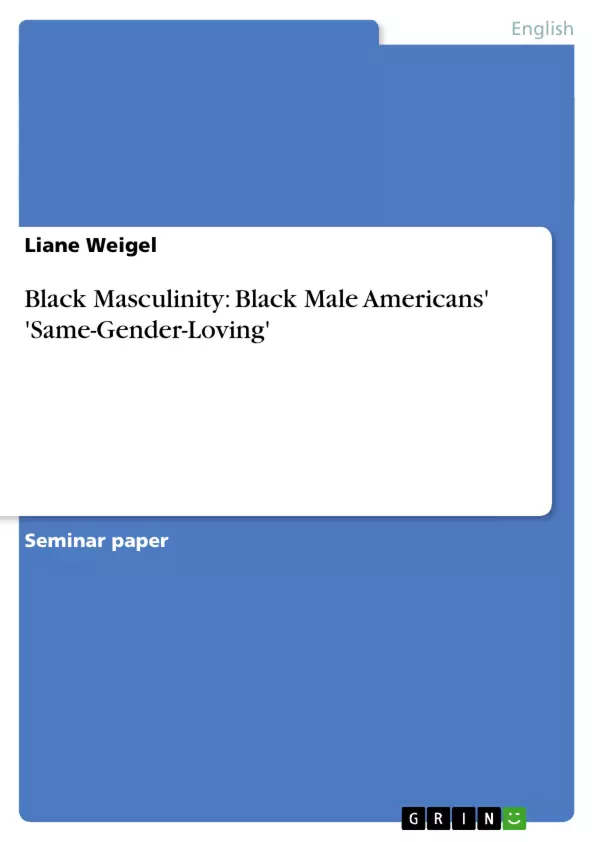Concerning the topic of masculinity the first and maybe the most important question is: What is masculinity? – Defined as “the quality of being masculine,”1 which means “having the qualities or appearance considered to be typical of men; connected with or like men,”2 the term “Black Masculinity” refers to “the qualities of being masculine and black.” This definition sounds very logical at first sight. Moreover, when using this term as normative standard, “the asymmetrical pendant to the more critically investigated femininity,”3 and therefore inventing fictional characters enacting or rejecting stereotypes of masculinity, it serves a certain order and makes life and abstract understanding easier. But if you reflect on the analysis of masculinity which should not be limited to “typical male behaviour and sexuality” and which should not only be a matter of individual identity but the organisation and representation of the social, these formal definitions are too easy. Therefore masculinity in a wider sense is understood as a form of identity of men that cannot be isolated from other dimensions of identity. Social conditions of manliness and equality are always connected with issues of race, class, gender and sexuality. Especially within the ideological structure of a patriarchal culture, heterosexual masculinity has traditionally been structured as the normative gender. Therefore patriarchal culture has a simple interpretation of gay men: “They lack masculinity,”4 which is reinforced by the statement: “If someone is attracted to the masculine, then that person must be feminine.”5 These beliefs create a dilemma about masculinity for men who are attracted to other men, that means homosexual white men, but also black men, if you think of living in a multicultural society and consider the colour of skin. 1 Sally Wehmeier/ A S Hornby (1999), Oxford Advanced Learner´s Dictionary Sixth Edition (Oxford University Press), p.786. 2 Ibid. 3 Maurice Berger et al. (1995), Constructing Masculinity (New York & London: Routledge) p. 2 f. 4R.W. Connell (1995), Masculinities (Cambridge. Cambridge Polity Press, p. 143. 5 Ibid, p. 143.
Inhaltsverzeichnis (Table of Contents)
- Introduction
- The Gay Movement: A Historical Background
- Dual Identities in Conflict: Black versus Gay
- Sexual Identity and Same-Sex Behaviour
- "Triangularity"- Being Accepted as an American in the Black and in the Gay Community
- "Same-Gender-Loving" and AIDS - "Same-Gender-Loving" Black Americans as Scapegoats
- Supporting "Same-Gender-Loving" Black Americans – Empowerment Organisations
Zielsetzung und Themenschwerpunkte (Objectives and Key Themes)
This paper aims to explore the complexities of Black masculinity and the experiences of "Same-Gender-Loving" Black male Americans. It delves into the conflicts arising from their dual identities as Black and gay within a patriarchal and often homophobic society.
- The impact of societal perceptions of masculinity on "Same-Gender-Loving" Black Americans
- The historical context of the gay rights movement and the role of Black Americans in its development
- The challenges faced by "Same-Gender-Loving" Black Americans in terms of self-identity and acceptance
- The concept of "triangularity" and its implications for the experiences of being Black, gay, and American
- The role of empowerment organizations in supporting "Same-Gender-Loving" Black Americans
Zusammenfassung der Kapitel (Chapter Summaries)
The introduction establishes the complexities of defining masculinity, particularly in the context of race and sexuality. It highlights the challenges of navigating identity in a society that often views "masculinity" as inherently heterosexual and white.
The second chapter provides a historical overview of the gay movement, emphasizing the significant contributions of Black Americans, from the Harlem Renaissance to the Stonewall Rebellion and the AIDS crisis. It illustrates how Black lesbian, gay, and bisexual individuals have played a crucial role in shaping societal understandings of homosexuality.
The third chapter delves into the specific challenges faced by "Same-Gender-Loving" Black Americans. It explores the conflict between their sexual identity and the societal pressures associated with traditional notions of Black masculinity.
The fourth chapter discusses the impact of the AIDS crisis on the "Same-Gender-Loving" Black community and how they were often marginalized and scapegoated.
The fifth chapter focuses on the role of empowerment organizations in providing support and advocacy for "Same-Gender-Loving" Black Americans.
Schlüsselwörter (Keywords)
The primary keywords and concepts explored in this paper include Black masculinity, "Same-Gender-Loving" Black Americans, gay rights movement, identity, intersectionality, "triangularity," AIDS, empowerment organizations, and societal perceptions of sexuality.
- Quote paper
- Liane Weigel (Author), 2002, Black Masculinity: Black Male Americans' 'Same-Gender-Loving', Munich, GRIN Verlag, https://www.grin.com/document/25634



